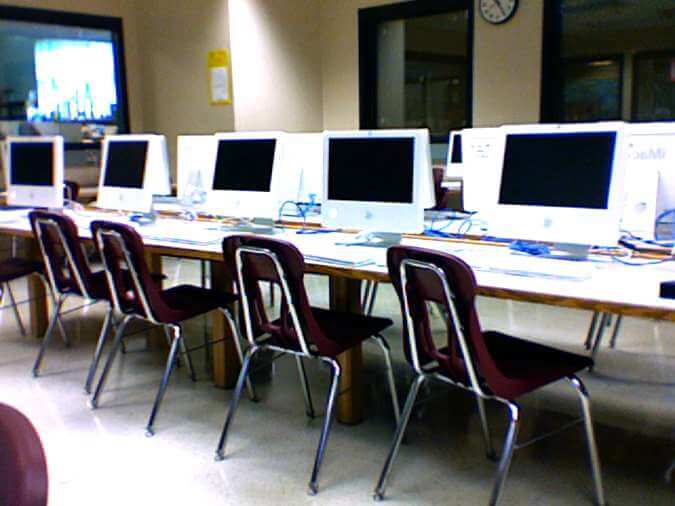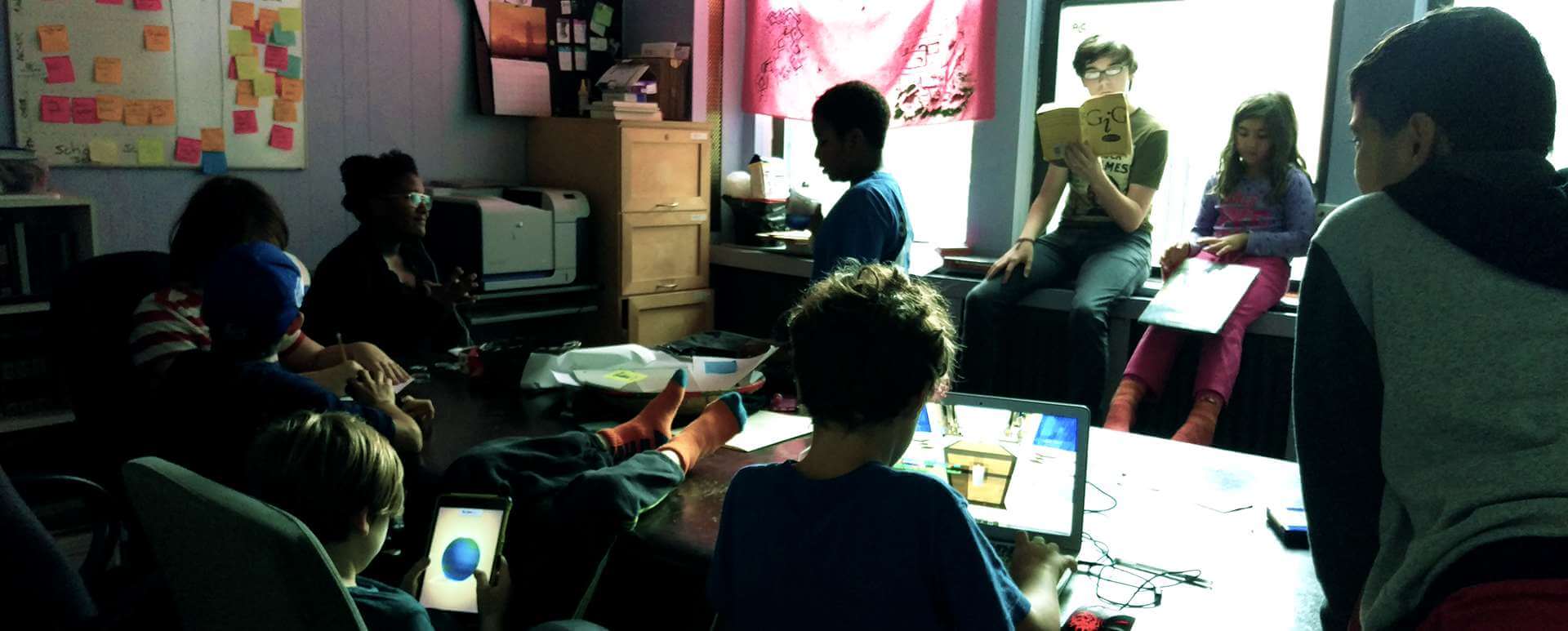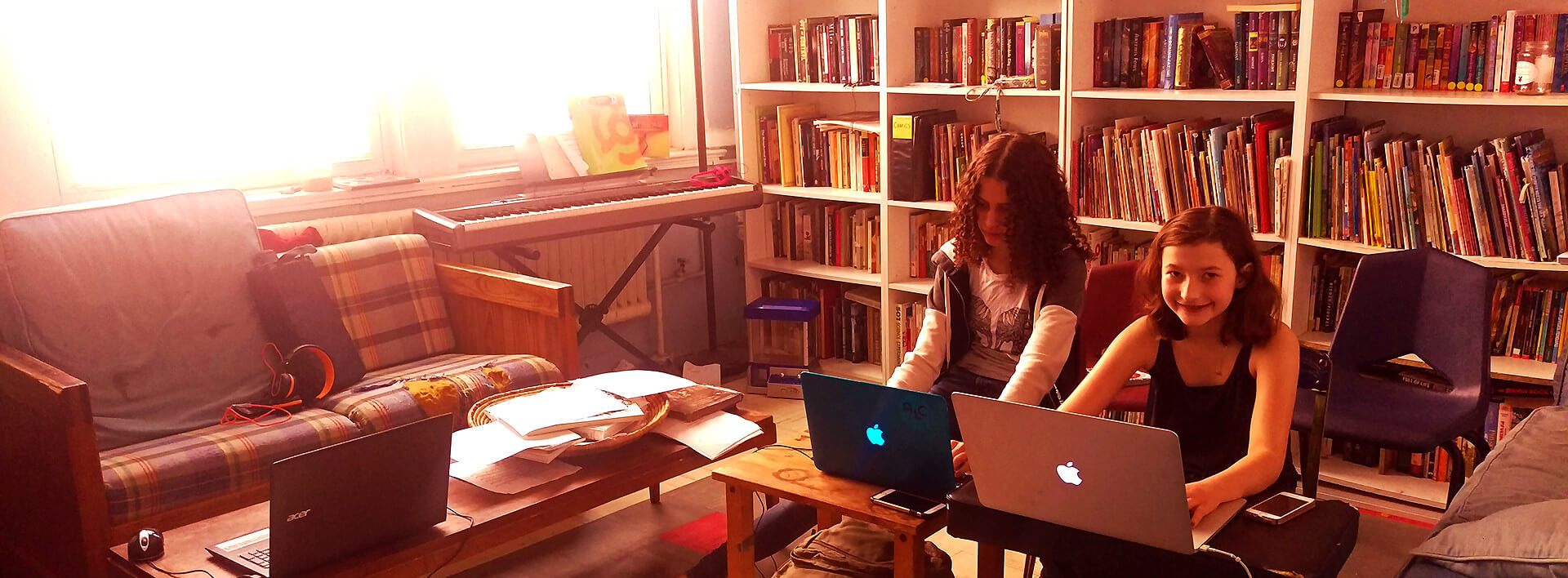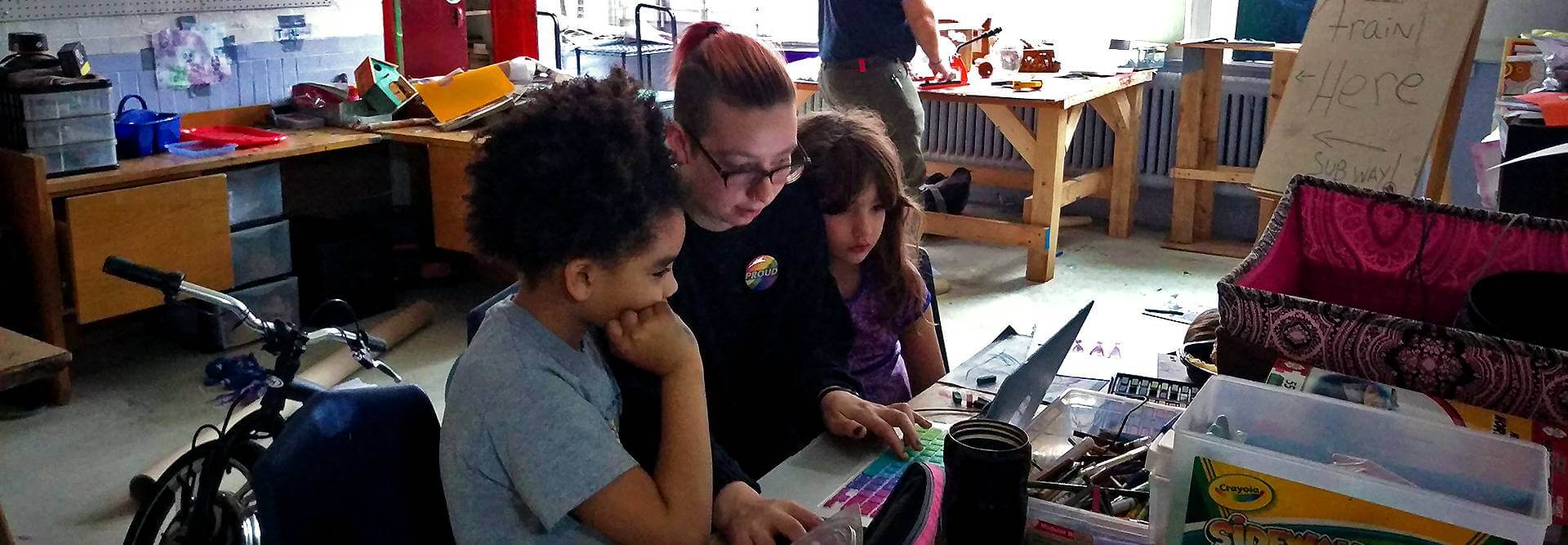My home town recently started to host screenings of the documentary Most Likely To Succeed. I went to a screening with an open mind, excited about the potential for interesting discussions about education.
The documentary, directed by Greg Whiteley, opens by discussing his daughter. Through Whiteley’s narration we learn his daughter has suddenly developed problems in her class work. The documentary cuts to a familiar scene: a parent teacher conference. The mother and teacher speak while the daughter begins to silently cry. The camera freezes and you hear Whiteley’s voice describing what he thinks his daughter is feeling. It was this moment at the start, the father speaking for his daughter, that turned out to be emblematic of things to come — a documentary that almost exclusively ignored children’s voices, experiences, and thoughts.
Diminishing children’s voices is always disappointing when discussing school, but in this particular case, it was the particular adults’ voices that were amplified that added to my utter disappointment. With a venture capitalist as a producer, I shouldn’t have been surprised by the overall focus of the documentary. The focus being that students should not be viewed as full human beings but rather as future workers to fulfill specific industry and economic goals.
I was further troubled by the “community discussion” that followed in my hometown. The panel did not include any actual young people or any teachers for that matter. It did include a representative from Google who gave a presentation on the future of education. Between a revised pull yourself up by your bootstraps personal narrative and a Michelle Obama name drop, the Google representative on the panel insisted that our current educational system isn’t broken, but like a smartphone, just needs a few updates.
Those updates, according to both the documentary and the Google rep, encompass a wide range of changes that on their surface appear more progressive (projects instead of standardized tests!), more child-centered (student led projects!) and overall better for teachers (more autonomy!). Their central theme was that the current educational model was built by a few good men to help prepare the country for the industrial revolution. This model worked for a long time. (Conveniently the documentary never mentions slavery/segregation.) However, they tell us, the model is currently outdated and needs be updated. These updates are necessary to prepare this next generation for the current industrial revolution, the technological revolution.
We were told that 60% of tomorrow’s jobs haven’t been invented yet. And yet while this fun fact was shared often during the panel, we were also told that tech jobs today need problem solving, creativity, teamwork and communication skills. And so, their argument goes, what schools need to do is to do more project-based education to teach kids these more important “soft” skills. The problem isn’t that I think that creativity or critical thinking is bad, or project-based learning doesn’t work, it’s the underlying logic that troubles me, one that isn’t unique to this documentary, nor to this particular Google representative.

The Google representative and the documentary, like the majority of Big Tech’s political maneuvers, use progressive language to essentially repackage an essential hierarchy of how our compulsory school system was created in the first place; let industry determine educational policy. Instead of having school to train people to sit still for 8 hours drilling the three Rs to work on an assembly line making lace or cars, the logic is to change school to train people to work creatively in teams to make apps. The skills may be different but the power structure is the same. Google, Microsoft, Facebook, and Amazon are playing the same roles as wealthy titans of nineteenth century America — producing monopolies, concentrating wealth, and thus wielding influence over institutions like education.
For Big Tech, the future is like a smartphone: shiny, sleek, efficient and consequently created and understood by a few for the endless consumption of the many. Big Tech sells their mindset as products and their products as a mindset. They become interchangeable, and both are sold as indispensable for a brighter tomorrow. As Google’s website on education reads, “To meet the future’s biggest challenges, students need an adaptive set of skills. We’re creating programs to ensure digital readiness in both students and teachers and directing Google tools and funding toward expanding computer science education.” Google is not alone in using vague progressive posturing to sell, convince, or convert people, groups, and institutions.
George Packer writing in the New Yorker article “Change the World: Silicon Valley transfers its slogans — and its money — to the realm of politics,” convey’s this idea well. “Like industries that preceded it, Silicon Valley is not a philosophy, a revolution, or a cause. It’s a group of powerful corporations and wealthy individuals...”
Big Tech’s interests can be easily boiled down to two interconnected forces: power and profit. Those two priorities determine the organizational structure, motives, and overall impact of these companies. Whether they are selling us software, hardware, or selling our data to other corporations, their goal of profit is the same. It shouldn’t be a surprise that Big Tech internal practices are not inclusive, are highly competitive, and drive them to be isolated from the public.
The most obvious example is tax evasion, but there are more visible examples of this selective isolationism, such as Google’s utilization of white buses for its employees so they don’t have to take public transport. Many tech companies have catered lunches so employees never have to leave. While on the surface this looks like opulence or thoughtful convenience, in reality it is another way to increase efficiency by decreasing the connection to the outside world — an outside world that is less predictable and harder to control. Yet this same desire to disconnect employees from the outside world also drives employers to bring order to it, to command it and pull it in directions that best serve their own needs. Big Tech needs the world — it needs state funded research and infrastructure, state controlled land, state law enforcers and, of course, state educated workers.

That isn’t to say that technology or ideas from computer science or programming don’t have world changing implications. It also isn’t to say that they don’t have positive effects. My point isn’t to deride technology but question the role of Big Tech in education development, policy and practices. I believe that cross-pollination between disciplines and communities is vital for growth and change. It’s hard to articulate the myriad ways computer technology has aided creativity, communication and collaboration. Technology of course has and will continue to have a profound effect on education. From the most obvious (hello internet) to something perhaps less known.
I recently visited the Agile Learning Center and saw in action ideas from the tech world have a profound effect. But I’m not talking about some kind of device, program, or app fresh off the market. I’m talking about an idea that helps create space for autonomy and community to flourish. Agile Learning Center (ALC) in New York City owes its name to agile management ideas from the tech world — adapting the ideas to support self-directed learning and community building. ALC uses computers and apps to track what they are planning, doing, making, and learning. But the apps and computers are not the bedrock of their practices. These borrowed, Big-Tech strategies help the Agile Learning Center to organize meetings, communicate effectively, and reflect on growth and change in order to realize their — to steal a phrase from Carla Bergman — common notions of autonomy, freedom, community, responsibility, trust, and joyous learning.

ALC is not about making or using the next big product. Rather, their process seeks to set clear intentions, share with others, and make changes when needed. It’s about cultivating agency and flexibility through structured conversations and feedback. Students say what they are planning to do in the morning, then, as one facilitator put it, magic happens, and everyone checks in in the afternoon to reflect on what they actually did. The magic in between intention setting and reflecting is self-directed learning, supported by facilitators. Their rules are called community agreements, made during democratic “change up” meetings where people bring up issues and address them.
Unlike Big Tech, where the goal is increasing cost efficiency and dispensing with inconvenient differences, ALC values and prioritizes transparency, process, and equity. They also recognize that learning is nonlinear, and doesn’t always create a quantifiable product. Learning is not a commodity given to the student from the teacher. ALC practices the belief that learning is reciprocal, collaborative, unpredictable and happening all the time within relationships and community. ALC realize that learning is messy because living is messy. Life is seldom linear or perfect. Rather, it’s like a pathway we are simultaneously creating and responding to, often in surprising ways. Or more elegantly expressed by Antonio Machado, “the path is made by walking.” ALC realizes that the path is made by walking, but never walking alone.
The ALC also doesn’t seek to eliminate conflict through conformity, but instead helps create community that holds space to deal with conflict productively, always working towards a collaborative resolution. Unlike ALC, Big Tech sees life’s conflict and differences as a something to actively avoid or to eliminate. They are driven by the need to make things “frictionless.” As George Packer again writes,
A favorite word in tech circles is “frictionless.” It captures the pleasures of an app so beautifully designed that using it is intuitive, and it evokes a fantasy in which all inefficiencies, annoyances, and grievances have been smoothed out of existence — that is, an apolitical world.
The problem here is we don’t live in a frictionless, apolitical world. We live in the real world, with misunderstandings, conflicting interests, a multitude of histories, and interlocking oppressive systems. Big Tech wants the oppressive status quo of patriarchal white supremacist capitalism because they gain profit and power from these systems. They desire nothing more than everyone just to go along with it because as they like to tell us they provide minimalist designed products and quick ways to find a restaurant. What more could we want?
While technology and at times Big Tech excels at solving efficiency or technical issues, they can’t solve ethical ones. As Virginia Eubanks writes in Automating Inequality, racism and sexism and poverty aren’t due to the lack of a product. Agile Learning Center isn’t a radical anti-oppressive space because it has purchased the right app. Rather, this kind of learning happens through the hard work of children, teenagers and adults willing to show up, be vulnerable, make commitments, be responsive and flexible all the while holding each other accountable in a non-hierarchical democratic community that prioritizes autonomy. The agile management framework helps facilitate learning and build community, it doesn’t demand standard outcomes that are easily measurable or categorized.
The ALC structure isn’t a commodity you can buy, nor is it a strict ideology that can be replicated like directions on the side of a box of brownie mix. ALCs recognize first and foremost that children are people, and people are complex, changing, living beings. And when you start with that, every learning community may look different, leading to diverse ideas, practices, and structures.
Eliminating diversity and enforcing top down decision making practices to increase efficiency and control isn’t just a corporate model but also one I’m seeing play out in school districts everyday. It’s the ongoing search for just the right behavior management system that will finally get the kids to stop fighting and start doing their homework. It’s the dream of many math curriculum departments that everyone is doing the same math in the same way, everywhere. It’s the plea from adults for kids to just do what they are told, behave the same way, no questions asked.The desires of Big Tech and the desires of many educational institutions mirror each other.
That technology can fix anything and everything is a belief Big Tech is eager to push. Public transportation? Apps will solve it! Health care? Apps will solve it! Kids not paying attention in class? Apps will solve it! There are dozens of programs and apps right now being marketed as “the answer” to a whole list of “problems” educators have defined. These “problems,” such as kids not doing their homework, are seen by some educators as easily fixable, and many educators see the answer in technology. Big Tech has found a hungry collaborator.
Education has so many competing and conflicting goals, it often finds itself using progressive ideas such as creativity, critical thinking, and citizenship for recruiting, rationalizing, and marketing. Big Tech also uses progressive language to increase their profitability. They use words like creativity and collaboration because they sound good to consumers. But this progressive language never translates to structural or systemic practices. The real message from the documentary and the majority of the respondents on the panel I attended, was not that creativity was a vital practice of a healthy child, but it was needed to make the child competitive in the marketplace. As Ryan Boren writes, concepts like innovation, design, and disruption are leaking into schools not for the benefit of students but for the benefit of Big Tech’s bottom line. Google wants to expand computer science education not because of some altruistic love of innovation but because they need more laborers. As Malcolm Harris wrote in the New Inquiry article “Reform School,”
Students can always be more effective future workers, and the enduring corporate education-reform movement and its lackeys in both political parties are always ready for a new push. At the end of the day, in a capitalist system, public education will produce wage laborers, and the American education system does a good job at producing the wage laborers that employers require. If it didn’t, employers would be forced to increase pay and train the skilled workers they need themselves.

Everyone has an opinion on education because everyone learns. And while there seems to be a multitude of voices pushing and pulling education, Big Tech’s voice seems to be ever growing. The question is: what happens when we prioritize the voices of adults over the voices of children and teenagers? What happens when we let success be defined by corporations? What will happen when we prioritize the voices of white rich people over the voices of everyone else? We can make an educated guess, because this is exactly how our current conventional education system was created. When this happens we will continue to get a system where the real stakeholders — children and teenagers — are ignored and controlled. We will get a system where the logic of capitalism, scarcity, competition, secrecy, and exploitation will bleed into the structures of the schools, affecting students, teachers, staff, and families. We will get a system where the violence of white supremacy and patriarchy will help create the structures of the schools. We will get a system where black students, indigenous students, students of color, LGBTQ students, disabled students, students with mental health issues and/or trauma, and students in poverty will continue to be shamed, harassed, excluded, coerced, and punished.
I wonder what the director’s daughter really thought while she sat there with her mother and her teacher talking about her as if she wasn’t even there. We never heard her opinions. Not even once. We need to stop ignoring our children. We need to stop seeing our children as only existing to help adults, as vessels for adults’ own desires and ideas, as symbols of adults’ own accomplishments and as tools and parts to further unjust economic institutions, structures, and systems. We need to start seeing them as who they are right now. People with their own set of ideas, beliefs, and motivations. Members of our communities. It’s time we stop talking over children and start talking with them. Dismantling unjust systems and creating new ones will take collaborative work. When it comes to schools, children and teenagers need to be at the center of that work — not tolerated or used as symbols but actively invited, included, and supported in action, dialogue, and creation. A start to this is to simply listen to them. Ignore the Google rep and ask a kid what they think of school.
If you enjoyed this article and feel called to give back to ASDE, here are ways you can support our work:
- Donate money
- Share our content with others! Click one of the buttons above to easily share on Twitter, Facebook, or email.
- Consider becoming a Contributor for Tipping Points
Tipping Points Magazine amplifies the diverse voices within the Self-Directed Education movement. The views expressed in our content belong solely to the author(s). The Alliance for Self-Directed Education disclaims responsibility for any interpretation or application of the information provided. Engage in dialogue by reaching out to the author(s) directly.






